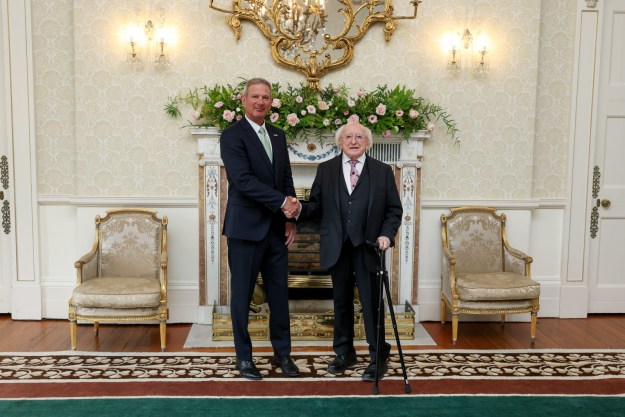Irish voters on Oct. 24 will elect the country’s tenth president under the constitution their ancestors adopted in 1937. Irish language scholar Douglas Hyde was nominated as the first president in 1938 by the country’s two main political parties, avoiding a contested election.
“Not a word of English was spoken at the inauguration of the Protestant as the head of the Catholic state,” the Associated Press reported to American newspaper readers. Americans in several markets such as New York/New Jersey, Massachusetts, and Washington, D.C. also were able to listen to a radio broadcast of the Irish language inaugural from Dublin.[1]”Dr. Hyde Inducted As Irish President”, Philadelphia Inquirer, June 28, 1938, and other papers. Radio program listings in multiple papers.
Nine of every 10 Irish citizens in 1938 were Catholic, and many aspects of the country’s political and social life were certainly influenced by the Church. But the new constitution that began to transform the 26 counties of southern Ireland from the Irish Free State, created in 1922 as a dominion of the United Kingdom, “did not declare Catholicism the state religion, to the disappointment of my zealous Catholics.” The 1937 constitution also did not declare an Irish republic, though the document defined the state as having 32 counties.[2]Diarmaid Ferriter, The Transformation of Ireland. [New York: Overlook Press, 2005], 369-70.
Some American news analysts framed Hyde’s selection as an olive branch to the six partitioned counties of North Ireland, which was roughly two thirds Protestant at the time.[3]In 1937, 30.5 % Presbyterian; 27% Church of Ireland; 4.7% Methodist. “Breakdown of population in Northern Ireland according to Religion, 1861-1991” at CAIN Archive. Catholics now outnumber … Continue reading But Hyde’s ascendance to the new figure head position of president did not reassure northern hardliners. The Ulster Unionist Party of Sir James Craig solidified its hold on power in the north during an election earlier in 1938. The Anglo-Irish Trade Agreement of that year, which ended a five-year dispute over tariffs and transferred control of several naval ports from Britain to Ireland, further reinforced northern recalcitrance.
Hyde’s religious affiliation was not the only thing that made him an unconventional choice. “Politicians usually want a practical man as the head of the state, but Dr. Hyde is a poet,” observed Milton Bronner of the Newspaper Enterprise Association. “The dominant cry in Europe is for young men as leaders, but the Irish chose Dr. Hyde, who is 78.”[4]”Aged Poet, ‘Enemy of None,’ To Be President of Ireland”, Pittsburgh Press, June 5, 1938, and other papers. For more on Bronner, see my post: “Could Maine potatoes have … Continue reading
Bronner’s analysis and other American press reports about Hyde’s inauguration noted his 1906-07 tour of the United States to raise money and awareness for the Gaelic League. These same stories mention that Eamon de Valera, as taoiseach, or prime minister, continued to hold the real political power in southern Ireland. But I have not found any American coverage that recounted de Valera’s 1919-20 U.S. tour as “president of the Irish republic.”
No such position or country formally existed at the time. De Valera’s real title was Príomh Aire, the chief minister or president of Dáil Éireann; the separatist parliament established in January 1919 by Sinn Féin candidates who won Irish constituencies in the December 1918 British general election. The title of president of Ireland was bestowed on de Valera by Irish American supporters to more easily convey his leadership position to American audiences.
In 1938, at least one letter to the editor writer in Ireland questioned the new title of Irish president, even if the American press missed the historical irony. The Dublin writer noted not only that de Valera had declared himself president in 1919, but also that Pádraic Pearse made the same claim at the 1916 Easter Rising. “Apparently we are now expected to forget that the Irish republic ever existed, or that the blood of Ireland’s greatest men was shed in its defense, and to regard the history of Ireland as commencing on the date of the enactment of de Valera’s new constitution.”[5]”President of Ireland” in “Our Readers’ Views On Topics Of The Day”, Irish Independent, June 27, 1938.
Afterward:
- Full republic status came to the 26 counties of southern Ireland in 1949. The 1937 constitution’s claim on a 32-county state was amended in 1998 as part of the Good Friday Agreement.
- De Valera transitioned from taoiseach to president in 1959. He held the latter position until 1973.
- The Irish Times has ranked Hyde as second best among the nine presidents of Ireland, with de Valera placed at seventh. See their list.
The two candidates vying for the Irish presidency later this month are Catherine Connolly, who was raised Catholic but describers herself as areligious, and Heather Humphreys, a Presbyterian by religious affiliation who describes her politics as moderate Irish republicanism rather than Protestant unionism. Connolly is a fluent Irish speaker, while Humphrey struggles with the language. As mentioned in the previous post, whoever wins the election will become Ireland’s third woman president.
References
| ↑1 | ”Dr. Hyde Inducted As Irish President”, Philadelphia Inquirer, June 28, 1938, and other papers. Radio program listings in multiple papers. |
|---|---|
| ↑2 | Diarmaid Ferriter, The Transformation of Ireland. [New York: Overlook Press, 2005], 369-70. |
| ↑3 | In 1937, 30.5 % Presbyterian; 27% Church of Ireland; 4.7% Methodist. “Breakdown of population in Northern Ireland according to Religion, 1861-1991” at CAIN Archive. Catholics now outnumber Protestants in Northern Ireland by 45.7% to 43.5%. |
| ↑4 | ”Aged Poet, ‘Enemy of None,’ To Be President of Ireland”, Pittsburgh Press, June 5, 1938, and other papers. For more on Bronner, see my post: “Could Maine potatoes have relieved Irish hunger in 1925?“ |
| ↑5 | ”President of Ireland” in “Our Readers’ Views On Topics Of The Day”, Irish Independent, June 27, 1938. |



